திராவிடர்கள் முறை தவறிய பரம்பரையா?
கிறிஸ்தவ தொன்மக்கதையில் பிரளயத்திலிருந்து (கிறிஸ்தவ நம்பிக்கையின் படி ஏசுவின் தகப்பனான) யஹீவா தேவனால் நோவா என்பான் காப்பாற்றப்படுகிறான். ஏனெனில் அவனே யஹீவா தேவனுக்கு விசுவாசமானவனாம் ஆனால் அவன் அதீதமாக திராட்சை மது அருந்தி வெறியில் ஆடை நழுவக் கிடக்கிறான். இனி பைபிள்:
அப்போது கானானுக்கு தகப்பனாகிய காம் தன் தகப்பனுடைய நிர்வாணத்தைக் கண்டு வெளியில் இருந்த தன் சகோதரர் இருவருக்கும் அறிவித்தான். அப்பொழுது சேமும் யாப்பேதும் ஒரு வஸ்திரத்தை எடுத்துத் தங்கள் தோள் மீது போட்டுவித்து பின்னிட்டு வந்து தங்கள் தகப்பனுடைய நிர்வாணத்தை மூடினார்கள். அவர்கள் எதிர்முகமாய் போகாதபடியினால் தங்கள் தகப்பனுடைய நிர்வாணத்தை காணவில்லை. நோவா திராட்சை ரசத்தின் வெறி தெளிந்து விழித்த போது தன் இளைய குமாரன் தனக்குச் செய்ததை அறிந்து கானான் சபிக்கப்பட்டவன், தன் சகோதரரிடத்தில் அடிமைகளுக்கு அடிமையாயிருப்பான். சேமுடைய தேவனாகிய கர்த்தருக்கு ஸ்தோத்திரம் உண்டாவதாக ; கானான் அவனுக்கு அடிமையாயிருப்பான். யாப்பேதை தேவன் விர்த்தியாக்குவார் ; அவன் சேமுடைய கூடாரங்களில் குடியிருப்பான் கானான் அவனுக்கு அடிமையாயிருப்பான் என்றான். (ஆதி 9: 22-27)
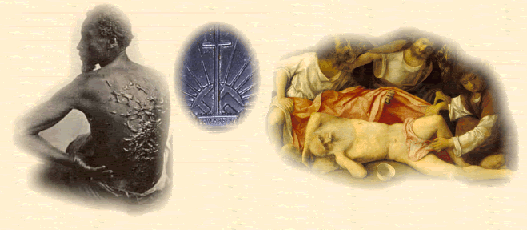
இந்த பைபிள் வாசகங்கள்தான் கறுப்பின மக்களை அடிமைப்படுத்தவும் அவர்கள் மீது எண்ணற்ற கொடுமைகளை செய்ததுமான வரலாற்று நிகழ்வுகளை நியாயப்படுத்த கிறிஸ்தவ மிசிநரிகளாலும் போதகர்களாலும் பயன்படுத்தப்பட்டுள்ளது. கிறிஸ்தவம் எப்போதுமே இனவாதத்தை எதிர்த்ததில்லை என்பது மட்டுமல்ல எப்போதெல்லாம் இனவாத வெறுப்பியல் எழுந்துள்ளதோ அப்போதெல்லாம் அங்கே இனவாத வெறுப்பியலை தனது மத மேலாதிக்கத்துக்காக ஆதரித்துள்ளது. அது அமெரிக்க தோட்டங்களில் வதைக்கப்பட்ட ஆப்பிரிக்க கறுப்பின மக்களை கொடுமை செய்த வெள்ளையராகட்டும், ஹிட்லராகட்டும், ருவாண்டா இனப்படுகொலைகளாகட்டும் அல்லது ஈவெராவாகட்டும் அல்லது மு.கருணாநிதி ஆகட்டும். வெள்ளை மிசிநரி 'ஆராய்ச்சியாளர்கள்' அவர்கள் சென்ற பிரதேசங்களில் வாழ்ந்த வேற்று இன மக்களை ஹாமின் சந்ததிகளாக காட்டும் 'ஆராய்ச்சிகளில்' ஈடுபடுவர். இதன் மூலம் அவர்கள் முறை தவறியவர்கள் நாகரிகத்தில் வெள்ளையர்களைக் காட்டிலும் கீழே இருப்பவர்கள் அதே போல ஆன்மிக புலத்திலும் கிறிஸ்தவர்களைக் காட்டிலும் கீழே இருப்பவர்கள் அல்லது கிறிஸ்துவை எதிர்பார்த்து காத்திருப்பவர்கள் என்பதாகக் காட்டுவார்கள். கறுப்பின மக்கள் மீது கிறிஸ்தவம் அவிழ்த்துவிட்ட வன்முறைகளையும் அடக்கு முறையையும் இனப்படுகொலைகளையும் நியாயப்படுத்த இந்த விவிலிய இனவாத போலி ஆராய்ச்சி பயன்படுத்தப்பட்டதை ஸ்டீபன் ஆர் கெய்ன்ஸ் எனும் வரலாற்று பேராசிரியர் அவர் எழுதிய 'நோவாவின் சாபம்: அமெரிக்க அடிமை முறைக்கு விவிலிய அடிப்படையில் ஆதரவு' (Noah's curse: Biblical support for American slavery) எனும் நூலில் விவரித்துள்ளார். அதிலுள்ள சில விசயங்களை பார்த்தால் இந்த மிசிநரி கும்பலின் விவிலிய அடிப்படையிலான இன ஆராய்ச்சியின் பின்னால் இருக்கும் இரத்தம் பருகும் விசமத்தனம் விளங்கும்.
ஆக்ஸ்போர்டு பல்கலைக்கழகம் வெளியிட்டுள்ள இந்நூல் கூறும் தரவுகளை நோக்கிய பிறகு இந்தியாவில் இந்த இனவாத மத மேலாதிக்கவாதிகள் ஈடுபட்டுள்ள விசமத்தனங்களை காணலாம்.
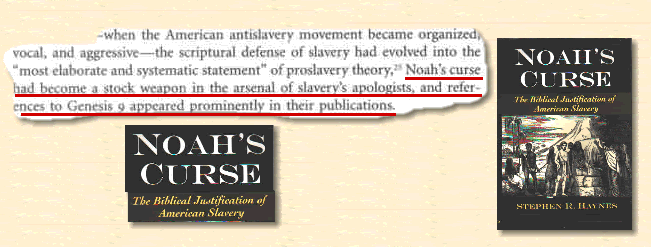
"அமெரிக்காவில் அடிமை அமைப்புக்கு எதிர்ப்பு அதிகமாக அதிகமாக அடிமை அமைப்பு ஆதரவாளர்கள் 'நோவாவின் சாபம்' என்பதை தங்கள் ஆயுதமாக பயன்படுத்த ஆரம்பித்தனர். அவர்களது பிரசுரங்களில் அடிமை அமைப்புக்கு ஆதரவான பிரச்சாரங்களில் விவிலிய-ஆதியாகமத்தின் 9 ஆவது அத்தியாயம் முக்கியமான இடத்தைப் பெற்றது."
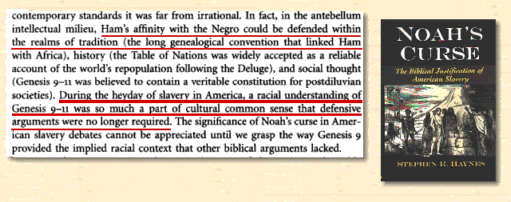
அமெரிக்காவில் உள்நாட்டு யுத்த காலகட்ட அடிமை-அமைப்பு ஆதரவு அறிவுசீவிகள் வட்டாரத்தில் ஹாமின் ஆப்பிரிக்க தொடர்பு ஏற்றுக்கொள்ளப்பட்ட பாரம்பரியமாகிவிட்டது. அமெரிக்க அடிமை அமைப்பின் உச்சநிலை காலகட்டத்தில் ஹாமினை ஆப்பிரிக்க கறுப்பின மக்களுடன் தொடர்பு படுத்துவதற்கு எவ்வித சான்றும் கூட தேவையில்லாமல் அது உண்மையென ஏற்றுக்கொள்ளப்படும் நிலை உருவாகிவிட்டது.
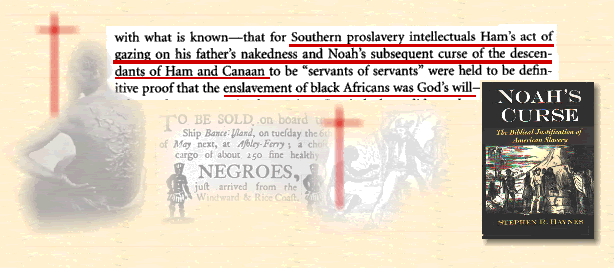
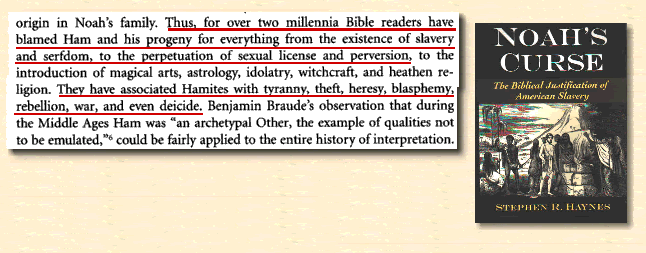
ஏறத்தாழ இரண்டாயிரம் ஆண்டுகளாக விவிலியத்தை வாசிப்பவர்கள் ஹாமையும் அவன் சந்ததிகளையும் அடிமை அமைப்பினை நியாயப்படுத்தவும் பாலியல் வக்கிரங்கள் பாலியல் ஒழுக்கமின்மை என்பவற்றுக்கு காரணமாகவும் காட்டி வந்துள்ளார்கள். விக்கிர வழிபாட்டு மதங்கள் உருவாக அவர்களே காரணம் என கூறினர். கொடுமை, திருட்டு, கலகங்கள் , தெய்வ நிந்தனை போர் இறைக்கொலை ஆகிய அனைத்துக்கும் அவர்களே காரணம் என்றும் குற்றச்சாட்டுகளை அவர்கள் சுமந்தார்கள்.
ஆக, ஆப்பிரிக்க கறுப்பின மக்களின் உண்மை வரலாறு மற்றும் அவர்களது சொந்த தொன்மங்கள் பாரம்பரியங்கள் ஆகியவை மறக்கடிக்கப்பட்டு கிறிஸ்தவ புனைகதை ஒன்று அவர்களின் வரலாறாக அவர்கள் மீது சுமத்தப்பட்டு அந்த புனனகதையின் அடிப்படையில் அவர்கள் மீதான கொடுமைகள் நியாயப்படுத்தப்பட்டன.
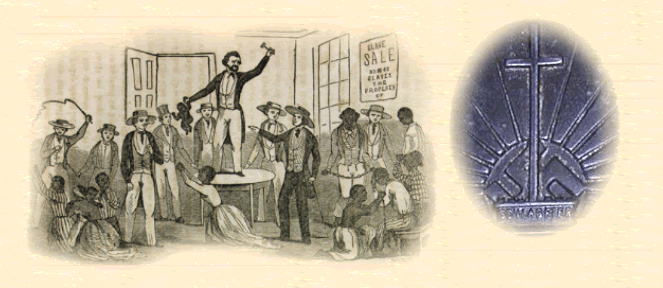

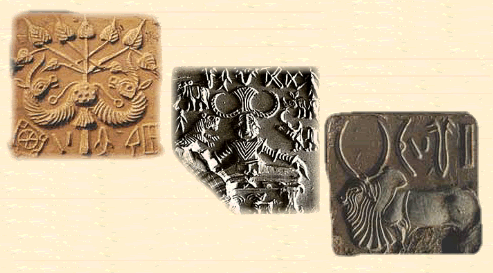
இரண்டு நூற்றாண்டுகளுக்கு முன்னர் கறுப்பின மக்களை அடிமைப்படுத்தவும் மதமாற்றவும் கிறிஸ்தவ மிசிநரிகள் செய்த இதே 'ஆராய்ச்சி' விசமத்தனம் இன்றைக்கு இந்தியாவில் அரங்கேற்றப்படுகிறது - அதுவும் அனைத்து கிறிஸ்தவ அமைப்புகளின் முழு முயற்சியுடன் என்பது அதிசயமாக இருக்கிறதா?
இதோ கிறிஸ்தவ டயஸீஸ்களில் விற்கப்படும் 'India is a christian nation' எனும் நூலில் காணப்படும் விசமத்தனமான இனவாத பிரச்சாரம்.
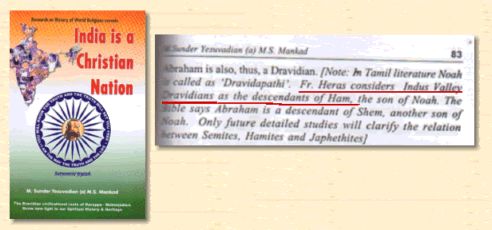

இந்நிலையில் இந்த மிசிநரி கோட்பாட்டினைக் குறித்து அண்ணல் அம்பேத்கர் கூறியதை இங்கே பார்க்க வேண்டும்.
"ஆரியப்படையெடுப்புக் கோட்பாடு என்பது ஒரு புனைவு ஆகும். அது ஒரு வக்கிரம் பிடித்த ஆராய்ச்சியின் விளைவாகும். அது தரவுகளின் அடிப்படையில் உருவானதல்ல. "என பாபா சாகேப் அம்பேத்கர் கருதினார். அவர் தெள்ளத்தெளிவாக கூறினார்:
"சாதியை குறித்து 'ஆராய்ச்சி' செய்யும் ஐரோப்பியர்கள் ஏற்கனவே நிறம் குறித்த முன்முடிவுகள் கொண்டவர்களாக இருந்தார்கள். எனவே அதனையே இந்திய சாதி குறித்த பிரச்சனைக்கும் அடித்தளமாக்கினார்கள். ஆனால் உண்மையிலிருந்து இது போல விலகிய விசயம் வேறெதுவும் இல்லை. டாக்டர்.கேட்கர் 'அனைத்து அரசரும் திராவிட-இனம் என கருதப்பட்டாலும் ஆரிய-இனம் என (இன்றைய ஆராய்ச்சியாளரால் -அநீ) ஆரியரே' எனக்கூறுவது முற்றிலும் சரியான முடிவாகும். எந்த ஒரு சமுதாயமும் ஆரிய இனமா திராவிட இனமா என்பதெல்லாம் இந்திய பாரம்பரியத்தில் ஒரு கேள்வியே இல்லை ஐரோப்பிய 'ஆராய்ச்சியாளர்கள்' அத்தகைய பிரிவினையயக் கொண்டு வரும் வரை."மேலும் அண்ணல் அம்பேத்கர் கூறுகிறார்:
"அந்தணர்கள் ஆரியரெனில் தலித்துகளும் ஆரியரே. அந்தணர்கள் திராவிடரெனில் தலித்துகளும் திராவிடரே. அந்தணர்கள் நாகர்களெனில் தலித்துகளும் நாகர்களே. அந்தணர்களும் தலித்துகளும் வெவ்வேறு இனத்தவர் எனும் ஐரோப்பிய கோட்பாடு உண்மைத் தரவுகளுக்கு எதிராக உருவாக்கப்பட்ட புனைவு ஆகும்."அண்ணல் அம்பேத்கர் வேதங்களையும் இதிகாசங்களையும் சமுதாய யதார்த்தத்தையும் கணக்கில் எடுத்து ஆராய்ந்து கூறிய இந்த முடிவினை அறிவியலும் உண்மை என ஒத்துக்கொண்டு உள்ளது.
அண்மையில் PNAS வெளியிட்ட ஆய்வு ஒன்று 'A prehistory of Indian Y chromosomes: Evaluating demic diffusion scenarios' (January 24, 2006 | vol. 103 | no. 4 | 843-848)
அதன் முடிவினை பின்வருமாறு கூறுகிறது:
"Y க்ரோமோஸோம் தரவுகளின் அடிப்படையில் அமைந்த ஆரரய்ச்சி முடிவுகள் இந்தியாவிற்குள் பெரும் படையெடுப்போ புலப்பெயர்வோ நடந்தது எனும் கோட்பாட்டுக்கு எதிராகவே அமைந்துள்ளன."ஆனால் இதையெல்லாம் கணக்கில் எடுக்காமல் மக்களின் அறியாமையை பயன்படுத்தி மதம் வளர்க்க போலி இனவெறி கோட்பாடுகளை பரப்பும் கிறிஸ்தவ மிசிநரிகளை என்னவென்பது. அல்லது தங்களை கீழ்மைப்படுத்தும் இனவாதக் கோட்பாடுகளை மிசிநரிகள் கூற அதனை ஏற்று அதற்கு 'ஆமாம் சாமி' போடும் நம்மூர் 'தமிழின காவலாளிகளை' என்னவென்பது?
அது போலவே நோவாவின் சந்ததிகள் உலகில் சென்று அங்குள்ள இனங்களானார்கள் என்கிற பிற இனத்தவர், மதத்தவர் மீது மிசிநரிகள் திணித்த கிறிஸ்தவ புனைகதையும் பொய் என நிரூபிக்கப்பட்டுள்ளது. ஆப்பிரிக்காவிலிருந்தே மானுட இனம் பரிணமித்து பரவியது மரபணு ஆராய்ச்சியால் தெளிவாக்கப்பட்டுள்ளது.

எனில் ஏன் இன்றைக்கும் இத்தகைய பொய்யான இனவாதங்களை 'ஆராய்ச்சி' என்ற பெயரில் மிசிநரிகள் பரப்ப வேண்டும்? இதுதான் மிசிநரி கருத்தாக்கங்களின் இரட்டை நிலை. கீழே உள்ள ஓவியத்தையும் புகைப்படத்தையும் பாருங்கள். இவற்றுக்கான தொடர்பு என்னவோ அதுதான் அன்பை போதிப்பதாக கூறும் கிறிஸ்தவத்துக்கும் அது தன் மேலாதிக்கத்துக்காக பரப்பும் இனவாத வெறுப்பியலுக்குமான தொடர்பு.

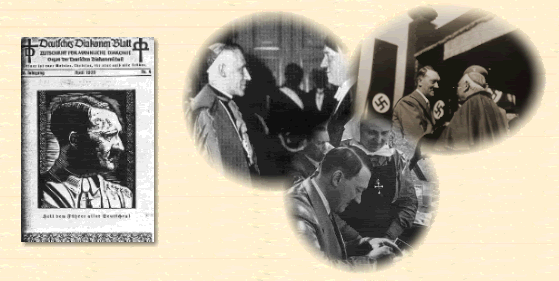
கிறிஸ்தவ இறையியல் இல்லாமல் நாசி வெறுப்பியல் இல்லை. மற்ற இனவாத வெறுப்பியல் கோட்பாடுகளான ஹட்டூ-டட்ஸி, திராவிட-ஆரிய இனவாதம் ஆகியவற்றுக்கும் இது பொருந்தும்.
உலகையே பாழ்படுத்தும் இந்த வியாதி அழிய மருந்தொன்றிருக்குது. அதுதான் பாரதத்தின் இந்து தருமம்.



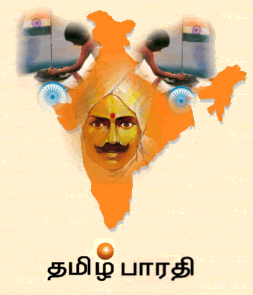
14 Comments:
ஒருபக்கம் பார்பனீயத்துக்கும், மறுபக்கம் இந்துவெறிக்கும் கொடி பிடிக்கும் உன் போன்றவர்களை பலர் நன்றாக அறிந்திருப்பதால், நீ ஒரு பசு தோல் போற்றிய கழுதை. உன்னால் எதைச் சொல்லியும் திராவிடர்களை உசுப்பேற்ற முடியாது. ஆண் உறுப்பில் சுன்னத் செய்யப்பட்டு இருக்கிறாதா என்று பார்த்து அறுத்து வீசிய குஜராத் மோடியின் மயிரை பிடுங்க முடியுமா என்று பார். அதன் பிறகு திராவிடர் பற்றி பேசும் யோக்கிதை கொள்ளலாம்.
Aravindhan,
Indians will surely understand that christianity is the only religion
that can protect indians from RSS and BJP fundemendalist.
You can not change dravidians by
your writings.We will do this under the leadership of Ragul Gandhi and the guidance of holy mother Sonia Gandhi.
So shut your mouth and stop writing nonsense.
Libin John.
`
நீ என்ன தான் பக்கம் பக்கமாக எழுதி கோடிட்டு கோடிட்டு காட்டி இந்து மதம் யோக்கியமானதாகவும், மற்ற மார்க்கங்களை இழிவானதாக காட்ட முயற்சித்தாலும் உனக்கு வெற்றி கிடைக்காது. பேச முடியாத, பார்க்க முடியாத, கேட்க முடியாத, தன் மீது உட்கார்நதிருக்கும் அற்ப ஈயை கூட விரட்டி தன்னை பாதுகாக்க முடியாத கல்லை கும்பிட்டு, அதனிடம் முறையிட்டு பகுத்தறிவை அடகு வைக்கும் கும்பலே, உன்னுடைய மதக்கோட்பாடுகள் மனிதனை பிறப்பால் கேவலபடுத்துவதும், பகுத்தறிவு வெட்கி தலைகுனியும் வகையில் இருக்கும் நிலையில் அடுத்தவனை பற்றி பேச உனக்கு யோக்கியதை என்ன இருக்கு? என்னுடைய இந்த பின்னூட்டத்தை கூட வெளியிட முடியாமல் இருக்க போகும் கோழை நீ என்பதும் எனக்கு தெரியும்.
I remember watching a program on national geographic channel saying that indians descended from africa.... Now your article has made me clear on this issue....
Thank you.....
அ நீ ஐயா,
மிகவும் அருமையான ஆராய்ச்சிக் கட்டுரை. தங்களின் ஆழ்ந்த அறிவும் தெளிவும் புலப்படுகிறது. கிருத்துவ மிசினரி குள்ளநரிகளின் இனவெறியை நன்றாக தோலுரித்துக்காட்டியிருக்கிறீர்கள்.
இந்த கருத்துக்கள் பட்டிதொட்டிகளில் எல்லாம் அறியப்படவேண்டியவை. நம் சமுதாயம் விழிப்புணர்வு பெற்று இந்த சக்திகளை நன்றாக அடையாளம் கண்டுகொள்ளவேண்டும். அன்றில், இவர்கள் எப்போதும் பிரித்தாளும் விஷமத்தனத்தை தொடர்ந்துகொண்டே இருப்பார்கள்.
நன்றி
// 'India is a Christian Nation' எனும் தலைப்பில் வெளியிடப்பட்ட ஒரு கிறிஸ்தவ பிரச்சார நூலில் //
இந்திய மக்கள் தொகையில் 3% இருக்கும் மதத்தினர் கிறிஸ்தவர்கள். எத்தகைய திமிரும், ஆக்கிரமிப்பு மனப்பான்மையும் இருந்தால் இப்படி ஒரு தலைப்பு வைத்து புஸ்தகம் போடத் துணிவார்கள்?
இந்த விஷ விருட்சங்களின் இனவாத இயல்பு பற்றிய பல தகவல்களை அருமையாக அளித்திருக்கிறீர்கள்.
நாட்டின் இறையாண்மைக்கு எதிரான இந்தச் செயலை எல்லா ஊடகங்களிலும் அம்பலப் படுத்த வேண்டும்.
சேதமில்லாத *ஹிந்து*ஸ்தானம் - இதை தெய்வமென்று கும்பிடடி பாப்பா!
- பாரதி
Mr Arivindan, Don't bother about people like dravidan kusu and john who are whacking you with their vulgar comments....
Continue to write....We are here to read....
கட்டுரையையும், அதற்கு வந்த பின்னூட்டங்களையும் படித்தேன்.
கட்டுரை குறித்து - எதிர்பார்க்கக்கூடியதுதான் என்றாலும் ஒவ்வொருமுறையும் அதிர்ச்சி அலைகள் ஏற்படுகின்றன.
ஆரம்ப பின்னூட்டங்கள் குறித்து - தன் மனைவியின் கள்ளத்தொடர்பு பற்றி முதன்முதலில் கேள்விப்படும் கணவர்களின் எதிர்விளைவு.
//பேச முடியாத, பார்க்க முடியாத, கேட்க முடியாத, தன் மீது உட்கார்நதிருக்கும் அற்ப ஈயை கூட விரட்டி தன்னை பாதுகாக்க முடியாத கல்லை கும்பிட்டு, அதனிடம் முறையிட்டு பகுத்தறிவை அடகு வைக்கும் கும்பலே,//
நகைச்சுவையாக எழுதுவதில் இஸ்லாமிஸ்டுகளுக்கு இணை அவர்கள் தாம்.
அது சரி, அல்லாஹ் என்ன பேச முடிகிறவரா? எங்கே பேசச் சொல்லுங்கள் பார்ப்போம்? காபாவின் மேலே ஏழு வானங்களுக்கப்பால் உட்கார்ந்து கொண்டு உலகை பரிபாலித்துவருகிற அவரை காபாவின் மீது உட்காருகிற ஈயை ஓட்டச் சொல்லுங்கள் பார்ப்போம் - காபாவை மீட்பதற்குக் கூட பிரெஞ்சுப் படைகள் வரவேண்டியிருந்தது. பலமுறை இடிக்கப்பட்டு மீண்டும் மீண்டும் விதவிதமான விதங்களில் கட்டப்பட்டது காபா - அப்போதெல்லாம் இந்த பேச முடிகிற, ஈயோட்ட முடிகிற அரபிக் கடவுள் எங்கே போயிருந்தார்?
முகமதுவுக்கு யூதப் பெண்மணி விஷம் வைத்து கொலை செய்தபோது அல்லாஹ் எங்கே போனார்? முகமதின் குடும்பமே நிர்மூலமாக்கப்பட்டபோது அல்லாஹ் எங்கே போயிருந்தார்? முகமதின் செல்லப் பேராண்டிகள் கொடூரமாக கொலை செய்யப்பட்டபோது அல்லாஹ் எங்கே போயிருந்தார்? 1000 ஆண்டுகாலம் பதூயின்களாக, காட்டுமிராண்டிகளாக அரபிக்கள் அலைந்தபோது அல்லாஹ் எங்கே போயிருந்தார்? பாபர் மசூதி இடிக்கப்பட்ட போது அல்லாஹ் எங்கே போயிருந்தார்? ஹஜருல் அஸ்வத் உடைத்து நொறுக்கப்பட்டபோது - காபா மீண்டும் மீண்டும் அழிக்கப்பட்டபோது அல்லாஹ் எங்கே போயிருந்தார்? ஈராக், போஸ்னியா, செச்னியா, ஆஃப்கானிஸ்தான் - இதெல்லாம் சர்வசக்தி படைத்த அல்லாஹ்வின் கண்ணில் படவில்லையா? ஈராக்கில் மசூதிகள் அமெரிக்கப்படைகளால் நிதம் நிதம் அழிக்கப்படும்போது அல்லாஹ்வால் ஏன் காக்க முடிவதில்லை?
பகுத்தறிவை எப்போதா வாழ்ந்து, கடவுள் தன்னிடம் பேசினார் என்று பொய் பேசி - தானும் ஏமாந்து, பிறரையும் ஏமாற்றிய முகமது சொன்னதாக பிறர் சொன்னவற்றில்(ஹதீதுகள்) சிலதை பிறர் தேர்ந்தெடுத்த(சஹியான) வசனங்களில் அறிவைத் தொலைத்து வழிகெட்டு, தினம் தினம் அல்லலுற்று கடவுள் என்ற பெயரில் குரானையும், ஹதீதையும் ஒப்புவிக்கும் முல்லாக்களிடம் தங்களது சுதந்திரத்தையும், அறிவையும் அடகுவைத்து விட்டு அலையும் இந்த கும்பல் பகுத்தறிவைப் பற்றி பேசுவதுதான் வேடிக்கையானது.
கல் என்றால் எல்லாம் கல்தான். பேசாத கடவுள் என்றால் எல்லாம் பேசாத கடவுள்தான். இதில் என்ன என் கடவுள் உசத்தி - உன் கடவுள் கையாலாகாத கடவுள் வாதம்.
மூடர்கள், மூடர்கள், தாமும் அழிந்து உலகையும் நிம்மதியிழக்க வைக்கும் மதவெறி பிடித்த மூடர்கள்!
இந்த மடையர்கள் போய் ஈராக்கில் அல்லாஹ்வின் துணையோடு அமெரிக்கர்களிடம் சண்டையிட்டு சுவனம் போகட்டும், இந்தியாவை நிம்மதியாக வாழ விடட்டும். அல்லது தாங்கள் பிரித்துக் கொண்ட 'பாக்ய ஸ்தான்' இப்போது இந்த மதவெறியால் கற்காலத்தை நோக்கிப் போய்க்கொண்டிருக்கிறது, அங்கே போய் இந்த பகுத்தறிவைக் காண்பித்து 'அல்லாஹ்வின் சுவனத்தை' புவியில் ஏற்படுத்தட்டும்.
இந்தியாவை Saint தோமையார் நல்வழிப்படுத்தினார். அதன் பின்னால் இந்தியாவெங்கும் கிருத்துவம் பரவியிருந்தது. இந்தியாவை "புனித பூமி" என மற்ற நாட்டுக்காரர்கள் எழுதியதும் இக்காரணத்தால்தான். கிருத்துவ மதத்தால் ரட்சிக்கப்பட்ட புனித பூமியாக இருந்த இந்தியாவை உங்களைப் போன்ற பார்ப்பனர்கள் சாத்தோனோடு சேர்ந்து சதி செய்து மீண்டும் துர்வழிகளில் ஈடுபடுத்தியதோடு அல்லாமல், எஞ்சி இருக்கும் இந்தியாவின் உண்மை மதமான கிருத்துவத்தை அழிக்க நினைக்கிறீர்கள்.
இந்தியாவின் ஆதி மதம் கிருத்துவமே.
///// கிறிஸ்தவ இறையியல் இல்லாமல் நாசி வெறுப்பியல் இல்லை. மற்ற இனவாத வெறுப்பியல் கோட்பாடுகளான ஹட்டூ-டட்ஸி, திராவிட-ஆரிய இனவாதம் ஆகியவற்றுக்கும் இது பொருந்தும். /////
அநீ ஐயா,
திராவிட இனவாதம், பிரிவினைவாதம் முதலானவற்றுக்கு ஒரு இறையியல் ஆதாரமாக இருந்திருக்குமா? இந்த இனவாதம் ஒரு ஆதிக்க வெறியை அடிப்படையாக வைத்து எழுப்பப்பட்டது என்றே நான் நினைத்திருக்கிறேன். இது குறித்து மேலும் விளக்கவோ, முடிந்தால் இன்னொரு பதிவாக போடவோ வேண்டும்.
நன்றி
Hi Arivindan,
Good research behind this article.
Dont bother about the ppl like "Thiravida KUSU" and "Libin John". They know they are worng. Just to support their side they commented this way.
We no need to bother to accept some one in the opposite side.
They did not argue with any points. Since what they told and known are all wrong.
Thanks
Subbu.
'India is a christian nation'
Please give more details about the author, publisher etc.
Book Review: The Curse of Ham: Race and Slavery in Early Judaism, Christianity, and Islam
Diana Edelman
Journal for the Study of the New Testament 2006; 28; 379
http://jnt.sagepub.com
David M. GOLDBERG, The Curse of Ham: Race and Slavery in Early Judaism,
Christianity, and Islam (Princeton: Princeton University Press, 2003). 449 pp. ISBN
069111465X. cloth $35.00.
In four parts Goldberg examines biblical and post-biblical images of Africans,
blackness and slavery. In Part I he focuses on ‘early Jewish’ views of the black African,
moving chronologically through biblical to post-biblical materials, the latter dated from
the third century BCE to 500 CE, in order to see continuities and discontinuities. In Part
II he examines Jewish views of, and attitudes toward, dark skin colour, which is a
broader issue than the ethnicity examined in Part I, since many ethnic groups had dark
skin. In Part III he examines the earliest references to black slavery, while in Part IV he
looks at subsequent identifications of Black and slave in biblical texts, after the development
of this equation within culture. This involves particularly a consideration of exegetical
changes in Jewish, Christian and Islamic literature concerning the story of the
curse of Ham.
The author notes that the biblical term Kush is not used exclusively to represent the
political empire south of Egypt; in the Table of Nations it includes groups living in the
southern and south-western parts of the Arabian peninsula. Linguistically, the languages
of groups on both sides of the Red Sea are related, so that historical contact and population
movement across the water is likely, allowing for possible ethnic relatedness. A Bedouin
group in the Negev was also known as Kush, as was a Mesopotamian descendant of
Nimrod, although the latter is almost certainly to be linked with the Kassite people. He
concludes that in Amos 9.7, Zeph. 2.12 and Isa. 8.1-2 Kushites are used as an example
of the most remote peoples in the world and does not express contempt against a darkskinned
people. He identifies this literary device as Greek in origin, finding it used in
Homer in the eighth century BCE, and suggests that it could have been adopted and
used by Hebrew prophets within the same century.
Post-biblical sources (Hellenistic, rabbinic and targumic literature) primarily identify Kush with Ethiopia and understand it to represent the southern end of the world. By the
first century BCE a further development took place: the linking of climate to behaviour.
Those in the south were intelligent but cowardly while those in the north were dimwitted
but courageous. In rabbinic midrash Kush(it) was taken to mean ‘beautiful’ in
some biblical passages.
Song 1.5-6 makes it clear that lighter-skinned women were preferred among the
Judean urban elite. This preference was found in Egypt, Greece and Rome and is
expressed in rabbinic and early Christian writings. Yet, Jews, Greeks and Romans saw
very dark or very light skin as aesthetically unpleasing. Kushi came to mean ‘darkskinned’
in some rabbinic texts.
Black African slaves were known in ancient Greece and Rome but were a minority;
they were a majority in Arabia at the time of Mohammad (650s CE). Although the
fourth-century CE Syriac Christian work Cave of Treasures connects slavery with darkskinned
people before the advent of Islam and so may reflect knowledge of Arabian
trade in African slaves in the early Byzantine period, Israel did not have long-standing
trade contacts with Africa like Arabia had. The numbers of black slaves in ancient
Israel would have been less than in the Arabian and Graeco-Roman worlds, since its
primary source of slaves would have been prisoners-of-war and it fought few battles in
Africa. As a small point of correction that does not affect the larger argument, it needs
to be noted that trade relations existed between the land of Canaan and Egypt as early
as the Early Bronze period (3500–2200 BCE). The exports were oil and wine, however,
and there is no indication of any interest in slave trade.
The name Ham has commonly been connected with two Hebrew roots associated
with ‘dark, black and hot’ (hmm) or ‘black or dark’ (hwm). In addition, however, it has
been linked to the native Egyptian ethnic term kmt, to Egyptian hm, meaning ‘servant’
or ‘majesty’, and to Arabic hmm, meaning ‘to feel bad, ill; to stink; to rot (as food)’. Its
ultimate derivation remains uncertain. The earliest specific designation of Ham as a
black person occurs in the Talmud, which dates, at the earliest, not later than 200 CE,
but may be a later addition no later than 370 BCE. The same idea is found in the Samaritan
text dating to the third to fourth century CE.
In discussing the reason why Jewish, Christian and Islamic texts switch Noah’s
curse of Canaan back to his father Ham or to Ham and/or his descendants, Goldberg
argues that it is natural to think that the sinner himself was punished, but this overlooks
the biblical principle that children suffered for the sins of their fathers (Jer. 31.29;
Ezek. 18.2). Goldberg concludes that there is no link between skin colour and slavery
in the Jewish sources of antiquity and late antiquity or in early Christian sources. The
first linkage is found in seventh-century CE Arabia, where ‘black’ became strongly
identified with the slave class. He also concludes that the Islamic conquest of Africa
and Asia led to the use of skin colour terms as ethnic markers instead of as relative
complexions. In addition, Arabic and Islamic Tables of Nations moved beyond skin
colour to present racial division based on external features.
The least convincing part of the discussion is the analysis of biblical texts, though
disagreements over the use of Kush to represent the political nation of Nubia versus a
stereotypical use to represent Black Africa do not impact the larger conclusion concerning
the lack of a link between skin colour and slavery in the Bible. The author’s assumption
that the time frames currently attached to prophetic books are historically accurate and
that most, if not all, of the contents of these books were spoken by the prophets whose
names are attached to the literary compositions has resulted in his failure to analyse
adequately the development of the use of the device of using distant nations to represent
peoples at the ends of the earth. Noting that this device appears in Homer, which he
dates to the eighth century BCE, he concludes that it could have been known and used
by Amos, who also lived in the eighth century BCE. By extension, he also identifies the
uses in Zeph. 2.12 and Isa. 18.1-2 as examples of this same device. There is no indication,
however, that biblical authors were familiar with Homer, and archaeological evidence
suggests that contacts with the Greek world were not widespread until the end of the
seventh century, when Greeks were used as mercenaries in Egypt and perhaps also in
Cisjordan at Mesad Hashavyahu and in the Negev. In addition, evidence of developing
trade in the form of East Greek pottery found at coastal sites only begins in this same
period. Thus, the transmission of this literary device, if Greek in origin, would not have
likely taken place before c. 630 BCE, after the times assigned to Amos and Isaiah in the
date superscriptions of these two books.
The twenty-fifth Dynasty that ruled Egypt from c. 780 to 656 BCE was Kushite,
which means that the references to Kush in the books of Amos and Isaiah could refer to
the historical political nation if linked to proclamations uttered at the time the date
superscriptions place the prophetic activities. This cannot be argued for Zephaniah, however,
unless one would want to claim that knowledge of Kush’s loss of control over
lower Egypt in 656 BCE had not been fully understood and that Josiah’s court thought
that Necho was of Kushite ancestry, like the kings of Egypt had been in recent memory.
The origin and development of the use of remote peoples to designate the ends of
the earth needs reconsideration. On the one hand, the case Goldberg makes for the use
of this device in Assyrian writing is weak, even though he notes that Sennacherib fought
African Kushites in Cisjordan in 701 BCE and Esarhaddon is known to have fought
against Tarhaqa twice in the Delta, defeating him the second time. Much more could
have been said, since Assyrian divine titulary regularly described Assur, father of the
gods, as ‘the one to whom Marduk, the foremost of the gods, has granted from olden
times the gods of lowlands and mountains, from the four corners of the world, that
they, with no exceptions, might honour him’. The idea of the Assyrian king ruling as
vice-regent of Assur’s earthly domain, which included the ends of the earth, is likely.
However, this does not mean that the kingdoms identified with the four corners of the
world, if specifically named, would have been stereotypical rather than reflective of the
extent of the Assyrian empire at the given time. References to Kush in Assyrian literature
could be to the political kingdom known and encountered by Assyrian kings and need
not be stereotypical of a distant people at the ends of the earth. Most Aramaic examples
of this device date to the late Persian or Hellenistic periods (fourth century BCE
onwards).
On the other hand, G’s claim that the device is clearly used in Darius’s inscription as a
southern boundary marker of his kingdom is not a straightforward use of the proposed
device either; it may be factual rather than stereotypical, since the Persians ruled Egypt
and established forts in traditional Nubian territory. It looks as though the stereotypical
versus political use of Kush became prevalent in the Hellenistic period. With this in
Amos, Isaiah and Zephaniah, he should logically argue that all are late, secondary
additions from the Hellenistic period. Having seen, however, that the references in
Amos and Isaiah could be to the political kingdom, Goldberg needs to develop more
fully his criteria for distinguishing between the use of Kush to designate the historical
political entity and the use to designate the most remote, known people on the earth. He
needs to clarify if the latter was a Semitic or Greek topos originally, or if it developed
independently in both cultures, and he needs to pay closer attention to the opportunities
for direct borrowing or cultural diffusion that would account for the use of the device
in biblical writings.
These points concerning the interpretation and dating of biblical texts do not undercut
the larger thesis that the widespread equation of slavery with Africans and black skin
seems to have arisen in the fourth century CE at the earliest, and so is not a biblical or
early Jewish idea. The author has dealt extensively with biblical and Jewish sources.
His book would have been strengthened even further had he delved into classical and
Islamic sources to the same degree, but he has done an extensive analysis of the
materials with which he is most comfortable and cannot be faulted for not wanting to
step much outside his areas of expertise. This volume will complement other studies of
slavery that deal with those two sets of sources and should allow both experts and
novices access to a wealth of relevant materials concerning ideas of slavery and images
of the black African in antiquity and late antiquity.
Diana Edelman
-----------------------------------
This journal is not for free.
Go to the link and check whether
it has reviews and articles useful
to you. If so email the author/
reviewer requesting a copy and
the author(s) may oblige.
Post a Comment
<< Home